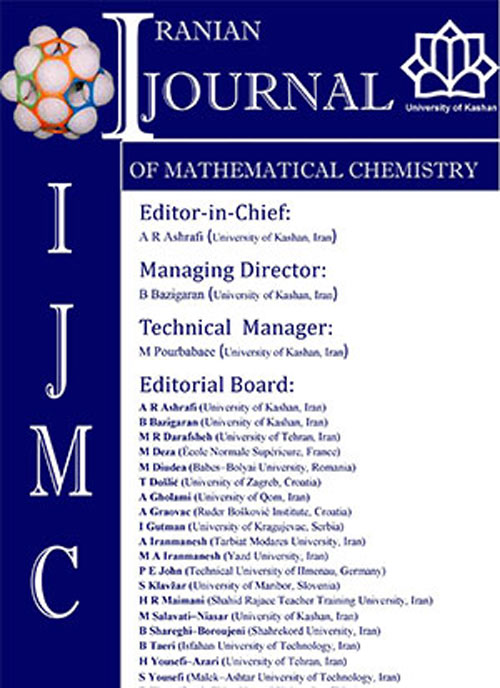فهرست مطالب

Iranian Journal of Mathematical Chemistry
Volume:8 Issue: 4, Autumn 2017
- تاریخ انتشار: 1396/09/12
- تعداد عناوین: 8
-
-
Pages 339-343A graph G of order n is said to be borderenergetic if its energy is equal to 2n − 2 and if G differs from the complete graph Kn. The first such graph was discovered in 2001, but their systematic study started only in 2015. Until now, the number of borderenergetic graphs of order n was determined for n 11. We now establish that there exist exactly 572 connected borderenergetic graphs of order 12.Keywords: Graph energy, Borderenergetic graph, Spectrum (of graph)
-
Pages 345-364The purpose of this study is to develop a new approach in modeling and simulation of a reverse osmosis desalination system by using fractional differential equations. Using the Legendre wavelet method combined with the decoupling and quasi-linearization technique, we demonstrate the validity and applicability of our model. Examples are developed to illustrate the fractional differential technique and to highlight the broad applicability and the efficiency of this method. The fractional derivative is described in the Caputo sense.Keywords: Reverse osmosis desalination system, Legendre wavelet method, DQL- technique, Caputo fractional derivative
-
Pages 365-375The variational iteration method(VIM) was extended to find approximate solutions of
fractional chemical engineering equations. The Lagrange multipliers of the VIM were not identified explicitly. In this paper we improve the VIM by using concept of fixed point iteration method. Then this method was implemented for solving system of the time fractional chemical engineering equations. The obtained approximate solutions are compared with the numerical results in the literature to show the applicability, efficiency and accuracy of the method.Keywords: Fractional differential equations, Variational iteration method, Fixed point theory, Chemical reactor -
Pages 377-390ýThe first multiplicative Zagreb index $\Pi_1(G)$ is equal to theý ýproduct of squares of the degree of the vertices and the secondý ýmultiplicative Zagreb index $\Pi_2(G)$ is equal to the product ofý ýthe products of the degree of pairs of adjacent vertices of theý ýunderlying molecular graphs $G$ý. ýAlsoý, ýthe multiplicative sum Zagreb index $\Pi_3(G)$ is equal to the product ofý ýthe sums of the degree of pairs of adjacent vertices of $G$ý. ýIný ýthis paperý, ýwe introduce a new version of the multiplicative sumý ýZagreb index and study the moments of the ratio and product of ýall aboveý indices in a randomly chosen molecular graph with tree structure of order $n$. þAlso, a ýsupermartingale is introduced by ýýDoob's supermartingaleý ýinequality.Keywords: Molecular graph with tree structure?, Multiplicative Zagreb indices, Moments, Doob's supermartingale? ?inequality?
-
Pages 391-401The aim of this paper is using the majorization technique to identify the classes of trees with extermal (minimal or maximal) value of some topological indices, among all trees of order n ≥ 12Keywords: Majorization, General first Zagreb index, Multiplicative Zagreb indices
-
Pages 403-411In this paper, an inverse nodal problem for a second-order differential equation having a chemical potential on a finite interval is investigated. First, we estimate the nodal points and nodal lengths of differential operator. Then, we show that the potential can be uniquely determined by a dense set of nodes of the eigenfunctions.Keywords: Boundary Value problem, Inverse Nodal problem, Eigenvalues, Nodal points
-
Pages 413-423Nowadays, numerical models have great importance in every field of science, especially for solving the nonlinear differential equations, partial differential equations, biochemical reactions, etc. The total time evolution of the reactant concentrations in the basic enzyme-substrate reaction is simulated by the Runge-Kutta of order four (RK4) and by nonstandard finite difference (NSFD) method. A NSFD model has been constructed for the biochemical reaction problem and numerical experiments are performed for different values of discretization parameter h. The results are compared with the well-known numerical scheme, i.e. RK4. Unlike RK4 which fails for large time steps, the developed scheme gives results that converge to true steady states for any time step used.Keywords: Michaelis-Menten model, NSFD Method, RK4 method
-
Pages 425-437ýA computational technique for solution of mathematical model of gas solution in a fluid is presentedý. ýThis model describes the change of mass of the gas volume due to diffusion through the contact surfaceý. ýAn appropriate representation of the solution based on the M"{u}ntz polynomials reduces its numerical treatment to the solution of a linear system of algebraic equationsý. ýNumerical examples are given and discussed to illustrate the effectiveness of the proposed approachý.Keywords: ?Fractional derivatives?, ?Gas ?solution, ?M{u}ntz polynomials?, ?Gaussian quadrature?, ?Collocation method?

